FRIDAY, MAY 29
■ This evening Mercury is as high in the western twilight as it will get during this apparition, although it has faded a bit since last week. It's now magnitude 0.0.
And look early in bright twilight to see if you can still catch Venus barely above the west-northwest horizon a mere 20 minutes after sunset, as shown below.
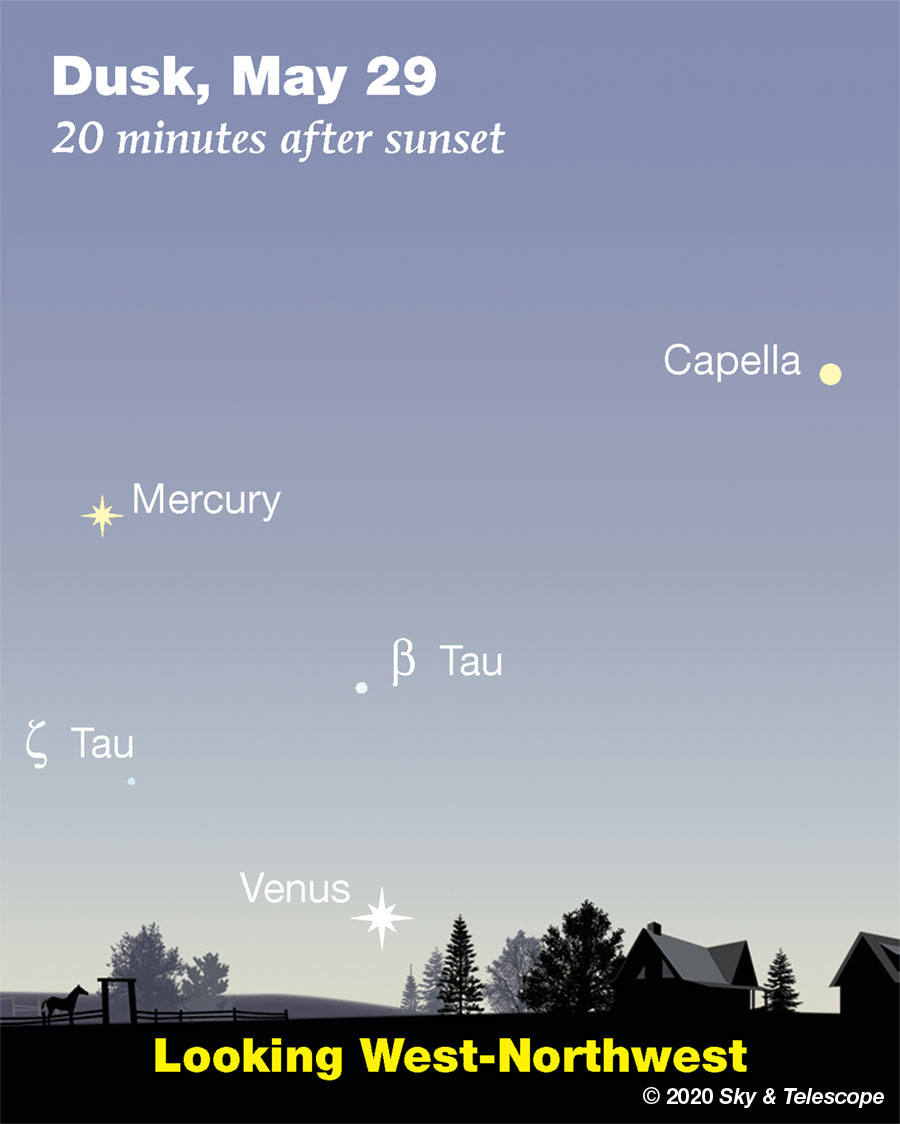
■ First-quarter Moon (exact at 11:30 p.m. Eastern Daylight Time.) As the stars come out the Moon is high in the southwest, below the belly of Leo's stick-figure lion pattern.
The Moon forms a nearly equilateral triangle with Leo's Regulus to its lower right and Gamma Leonis (Algieba), slightly fainter, more directly to the Moon's right, depending on your location. The triangle is just about perfectly equilateral, 8° on a side, at the time of late twilight for the East Coast of North America.
SATURDAY, MAY 30
■ Bright Capella is still up in the northwest in twilight, as shown above, but it sets in the northwest fairly soon after dark (depending on your latitude). That leaves Vega and Arcturus as the brightest two stars in the evening sky. Both are magnitude 0. Vega shines in the east-northeast. Arcturus is very high toward the south.
A third of the way from Arcturus to Vega, look for semicircular Corona Borealis, the Northern Crown, with 2nd-magnitude Alphecca as its one moderately bright star.
Two thirds of the way from Arcturus to Vega is the dim Keystone of Hercules, now lying roughly level.
Use binoculars or a telescope to examine the Keystone's top edge. A third of the way from the edge's left end to the right is 6th-magnitude M13, one of Hercules's two great globular star clusters. In binoculars it's a tiny glowing cotton ball. A 4- or 6-inch scope begins to resolve some of its speckliness. Located 22,000 light-years away far above the plane of the Milky Way, M13 consists of several hundred thousand stars in a swarm about 140 light-years wide.
SUNDAY, MAY 31
■ The Moon is waxing gibbous and high after dusk, one of the Moon's most popular phases and convenient places for backyard telescopic observers.
And when you're done with the Moon, notice the brightest little naked-eye star a couple finger-widths from it. That's 3rd-magnitude Gamma Virginis, or Porrima. (For North Americans it's roughly 3° to the Moon's left or lower left.) High power should resolve it into a rather close, equal-brightness binary pair, separation 3.0 arcseconds this year, aligned almost exactly north-south. Porrima's stars are both spectral type F0 V, somewhat larger and hotter than the Sun, and revolve around each other every 169 years in a highly elliptical orbit. They're 38 light-years away.
MONDAY, JUNE 1
■ After dark, 1st-magnitude Spica hangs below the waxing gibbous Moon in the south.
TUESDAY, JUNE 2
■ Constellations seem to twist around fast when they pass your zenith — if you're comparing them to the direction "down." Just a week and a half ago, the Big Dipper floated horizontally in late twilight an hour after sunset (as seen from 40° N latitude). Now it's angled diagonally at that time. In another week and a half it will be hanging straight down by its handle!
WEDNESDAY, JUNE 3
■ "Cassiopeia" usually means "Cold!" Late fall and winter are when this landmark constellation stands high overhead (seen from mid-northern latitudes). But even on hot June evenings, it still lurks low. As twilight fades out, look for it down near the north horizon: a wide, upright W, as shown below. The farther north you are the higher it'll appear, but even as far south as San Diego and Atlanta it's completely above the true horizon.
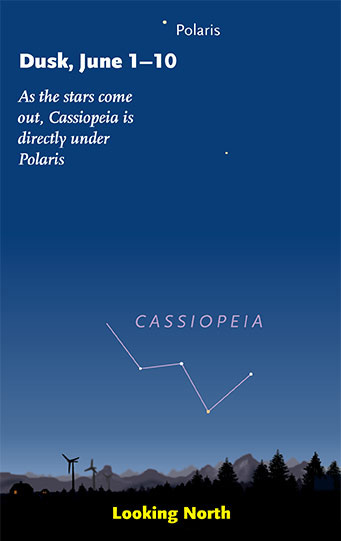
THURSDAY, JUNE 4
■ After dark, it's the turn of 1st-magnitude Antares to hang the same distance below the Moon as Spica did on Monday. Spica was twinkling pale bluish. Antares is more strongly orange.
FRIDAY, JUNE 5
■ Can you still catch Mercury in twilight, under Pollux and Castor as shown below? It's coming to the end of a nice evening apparition. Its next good evening appearance doesn't come until winter 2021.
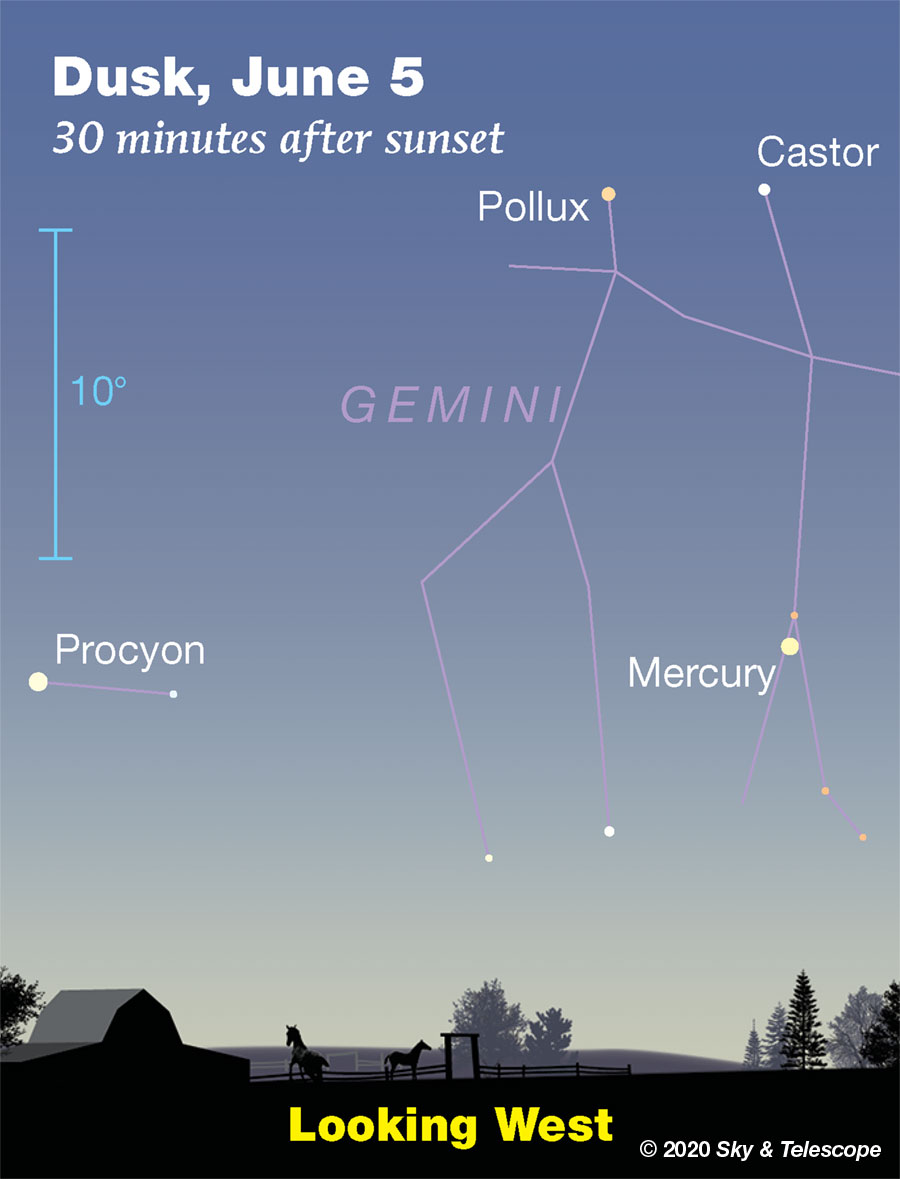
■ Full Moon (exactly so at 3:12 p.m. Eastern Daylight Time). As the stars come out, look to the right of the Moon (by roughly a fist at arm's length) for orange Antares and the other stars of upper Scorpius.
■ On this date UT the Moon undergoes a slight, almost undetectable penumbral eclipse for East Africa, the Middle East, South and Southeast Asia, and Australia. The Moon's southern side will be very slightly, subtly shaded for maybe 40 minutes centered on 19:25 UT. Map, diagram, and details.
SATURDAY, JUNE 6
■ For much of the spring at mid-northern latitudes, the Milky Way lies right down out of sight all around the horizon. But watch the east now. The rich Cassiopeia-Cepheus-Cygnus-Aquila stretch of the Milky Way starts rising up all across the east these nights, earlier and higher every week. A hint for the light-polluted: It runs horizontally under Vega, right through the Summer Triangle.
This Week's Planet Roundup
Mercury is having a nice apparition in evening twilight. Look for it in the west-northwest as twilight deepens. However, Mercury is fading: from magnitude 0.0 on May 30th to +0.7 on June 6th, a loss of half its light.
A telescope will show why. Mercury is rapidly waning in phase, from half-lit to a crescent this week, showing us less and less of its sunlit side.
This fact may not be entirely obvious in your scope — first because Mercury is a mere 7 arcseconds in diameter, and second, the atmospheric seeing is always poor at the low altitude where Mercury hangs in twilight. Get your telescope on it as early as you can. If you keep examining it, tweaking the focus and hoping for moments of better seeing, you'll eventually see quite a bit more than you did at first. As is true throughout visual astronomy.
Venus is basically out of sight, closing in on the Sun. They reach conjunction at 18h UT June 3rd, when Venus will pass less than one solar radius from the Sun's northern limb.
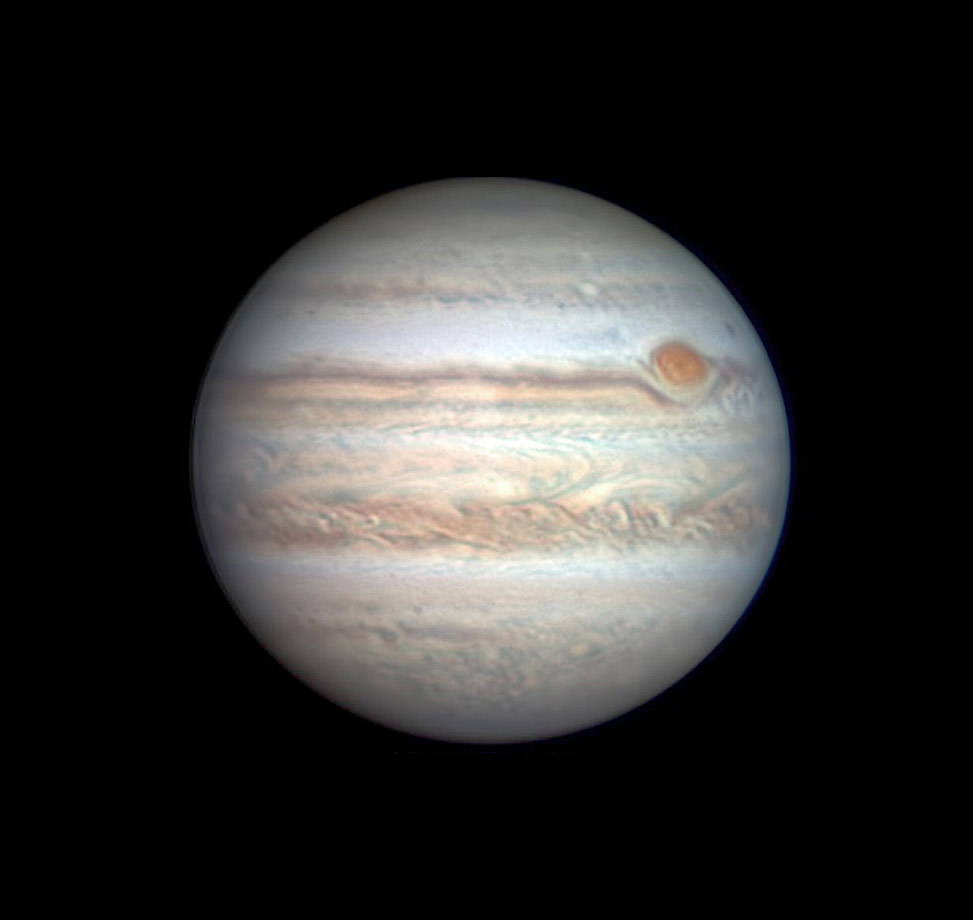
Mars, Jupiter, and Saturn (magnitudes, +0.1, – 2.5, and +0.4, respectively) shine in the southeast to south before and during early dawn.
Jupiter, the brightest, is on the right. Saturn glows pale yellow 4° to Jupiter's left. They both rise now around midnight daylight-saving time, depending on your location. They straddle the border of Sagittarius and Capricornus.
Mars, in dim Aquarius, is far (35° to 40°) to the left of Saturn as dawn begins. It has been slowly brightening and enlarging. In a telescope Mars is now 9 arcseconds wide: a little gibbous disk. Mars is on its way to an excellent opposition in early October, when it will reach an apparent diameter of 22.6 arcseconds.
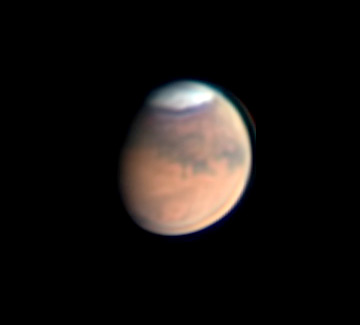
Uranus is hidden in the glow of dawn.
Neptune (magnitude 7.9, in Aquarius) is in the east-southeast before dawn begins, in the vicinity of Mars.
All descriptions that relate to your horizon — including the words up, down, right, and left — are written for the world's mid-northern latitudes. Descriptions that also depend on longitude (mainly Moon positions) are for North America.
Eastern Daylight Time (EDT) is Universal Time (UT, UTC, GMT, or Z time) minus 4 hours.
Want to become a better astronomer? Learn your way around the constellations. They're the key to locating everything fainter and deeper to hunt with binoculars or a telescope.
This is an outdoor nature hobby. For an easy-to-use constellation guide covering the whole evening sky, use the big monthly map in the center of each issue of Sky & Telescope, the essential guide to astronomy.
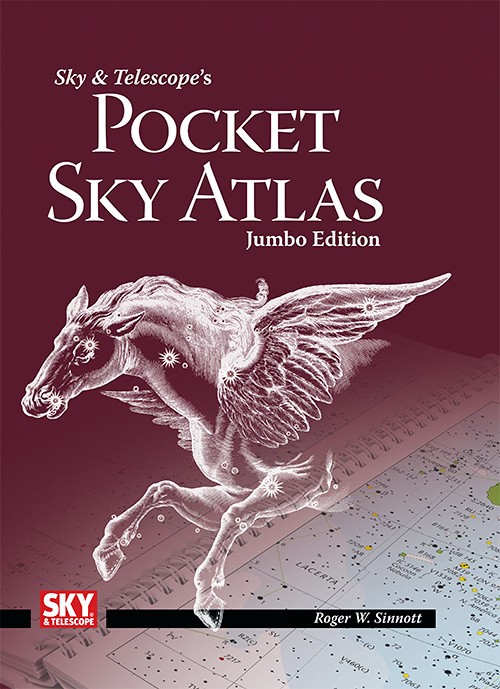
Once you get a telescope, to put it to good use you'll need a detailed, large-scale sky atlas (set of charts). The basic standard is the Pocket Sky Atlas (in either the original or Jumbo Edition), which shows stars to magnitude 7.6.
Next up is the larger and deeper Sky Atlas 2000.0, plotting stars to magnitude 8.5; nearly three times as many. The next up, once you know your way around, are the even larger Interstellarum atlas (stars to magnitude 9.5) or Uranometria 2000.0 (stars to magnitude 9.75). And read how to use sky charts with a telescope.
You'll also want a good deep-sky guidebook, such as Sky Atlas 2000.0 Companion by Strong and Sinnott, or the bigger Night Sky Observer's Guide by Kepple and Sanner.
Can a computerized telescope replace charts? Not for beginners, I don't think, and not on mounts and tripods that are less than top-quality mechanically (meaning heavy and expensive). And as Terence Dickinson and Alan Dyer say in their Backyard Astronomer's Guide, "A full appreciation of the universe cannot come without developing the skills to find things in the sky and understanding how the sky works. This knowledge comes only by spending time under the stars with star maps in hand."
![]() Audio sky tour. Out under the evening sky with your earbuds in place, listen to Kelly Beatty's monthly podcast tour of the heavens above. It's free.
Audio sky tour. Out under the evening sky with your earbuds in place, listen to Kelly Beatty's monthly podcast tour of the heavens above. It's free.
 6
6








Comments
Rod
May 31, 2020 at 6:11 am
mary beth. I did enjoy some great planet viewing this morning! Mars, Saturn, and Jupiter. Mars at 200x using red filter shows some surface features and red filter darkens the surface features, gibbous shape, and south polar cap very visible. Jupiter is approaching opposition on 14-July. Jupiter and its moons are something to see now in the telescope views. Enjoyable morning out 0400-0530 EDT. Saturn, rings with Cassini division distinct and Titan moon. Cloud bands on Saturn, especially noticeable using my red filter. I used my 90-mm refractor in the east pasture. By 0445 EDT, the sky was brightening in the east and continued as sunrise approached near 0543 this morning so I decided to come back in shortly after 0530. I am watching NASA TV live again on the web, watching the Dragon dock with ISS. Flight maneuvers getting Dragon ready for docking with the ISS is underway including the communications check and discussions with the astronauts. Very nice, yesterday the Dragon crew launch I watched, this morning observing Mars, Saturn, and Jupiter with my telescope and now back in for breakfast watching the Dragon and our astronauts approach ISS for docking and astronaut entry. Elon Musk wants SpaceX to go to Mars. This morning using my telescope, I was there! ---Rod
You must be logged in to post a comment.
mary beth
June 1, 2020 at 1:50 am
You have such a great set up! How long have you lived out there? Did you get interested in astronomy as a kid/college or was it something you got into as an adult?
You must be logged in to post a comment.
Rod
June 1, 2020 at 6:41 pm
mary beth, I have been out in the more rural area with horse farm since 1995. Prior - city living and not seeing much. I started using 7x50 binoculars in early 1960s. In 1991, I purchased my 90-mm refractor telescope, and later the 10-inch Newtonian. Both provide many hours of great viewing and fun when the weather is good, skies are clear and I use 10x50 binoculars too. Sometimes I just go out into the horse pastures and open fields with the binoculars, and in the winter, have a cowboy fire outside with cowboy coffee 🙂 Today I spent 4 hours chopping, splitting, and stacking more wood. Getting ready for some more cowboy coffee over the open flames :)---Rod
You must be logged in to post a comment.
mary beth
June 2, 2020 at 12:45 pm
Sounds like a very nice life! Hopefully when we get out to our place New Mexico we will be having a similar experience! The elevation of our property is 6800 feet so we have lots of cool air… It’s in the Lincoln national Forest as well so there are trees but also plenty of open spaces to view the stars! My husband is there working during the week and he can see the Milky Way and so many stars that he could never see in Houston. When we finally get there I will get your recipe for cowboy coffee LOL. I really wish my parents would have raised us in the country!
You must be logged in to post a comment.
David Dunn
June 1, 2020 at 5:06 am
My goodness Mars's polar cap seems quite large! May have to get my telescope out and look at it!
You must be logged in to post a comment.
Rod
June 1, 2020 at 6:47 pm
David Dunn, yes look at Mars with your telescope if you can. I used the 90-mm refractor early Sunday morning. 1.8x Barlow lens, 14-mm eyepiece, and a 9-mm eyepiece. Mars is showing a bit more detail as Earth and Mars get closer now. The south polar cap is distinct. I found views 130x to 200x worked well. You will need to be out early, I was out 0400 when viewing Mars.
You must be logged in to post a comment.
You must be logged in to post a comment.